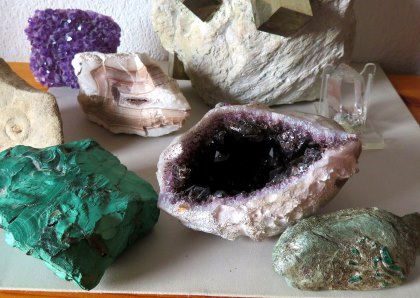|
Collecting minerals, also known as mineralogy or mineral
collecting, is a captivating hobby that involves acquiring, studying, and
appreciating the diverse and beautiful world of minerals and crystals found
in the Earth's crust. Minerals are naturally occurring inorganic substances
with distinct chemical compositions and crystal structures. Each mineral
exhibits unique properties, colors, and forms that make them fascinating
objects of study and admiration.
Here's an introduction and some information about collecting minerals:
Nature's Masterpieces: Minerals are nature's masterpieces, formed
over millions of years through geological processes. They come in a stunning
array of colors, shapes, and sizes, and their crystalline structures can
create mesmerizing patterns.
Scientific and Aesthetic Value: Mineral collecting combines
scientific curiosity and aesthetic appreciation. Collectors study the
physical and chemical properties of minerals, as well as their geological
formations. Additionally, the beauty of minerals has led to their use in
jewelry and decorative arts.
Variety of Minerals: Minerals encompass a vast range, including
quartz, amethyst, calcite, fluorite, tourmaline, and countless others. Some
minerals are prized for their rarity, while others are valued for their
striking visual appeal.
Locations and Geology: Minerals are found all around the world in
various geological settings. Collectors often find joy in exploring
different regions and uncovering specimens unique to specific locations.
Mineral Classification: Minerals are classified based on their
chemical composition and crystal structure. This system helps collectors
categorize and understand the relationships between different minerals.
Tools and Equipment: Basic tools for mineral collecting include rock
hammers, chisels, safety glasses, and collection bags. More serious
collectors may use specialized tools like UV lights to identify fluorescent
minerals.
Ethical Collection: Responsible collecting is essential to preserve
natural habitats and ecosystems. Some mineral locations are protected, so
it's important to research local laws and regulations before collecting.
Mineral Shows and Clubs: Mineral shows and exhibitions are excellent
opportunities to learn more about minerals, view impressive specimens, and
connect with other enthusiasts. Joining mineral clubs provides access to
resources, knowledge sharing, and field trips.
Mineral Identification: Identifying minerals involves observing their
physical properties such as color, hardness, luster, and crystal form.
Advanced collectors may use techniques like X-ray diffraction for accurate
identification.
Display and Storage: Displaying and storing minerals requires proper
care. Showcase cabinets, display cases, or shadow boxes help protect
minerals from dust and damage, while acid-free paper or boxes preserve their
condition.
Photography: Many collectors document their mineral specimens through
photography. High-quality photos capture the intricate details and vibrant
colors of minerals.
Personal Enjoyment: Mineral collecting is a journey of exploration,
discovery, and appreciation. Whether you're drawn to the scientific aspects,
the aesthetic beauty, or the thrill of finding rare specimens, collecting
minerals offers a rewarding and fulfilling hobby.
The value of minerals for collectors can vary widely
based on factors such as rarity, crystal quality, color, size, and demand
among enthusiasts.
Here are some particularly valuable minerals that are
often sought after by collectors:
Diamond: Diamonds are one of the most valuable and sought-after
minerals due to their hardness, brilliance, and association with luxury.
Fancy colored diamonds, such as pink, blue, and green, are especially rare
and valuable.
Gold: Gold is treasured for its natural beauty and rarity. Specimens
of native gold, crystallized gold, and intricate gold nuggets are highly
prized by mineral collectors.
Emerald: Emerald is a rare and precious green gemstone variety of
beryl. Large, well-formed emerald crystals with rich color and minimal
inclusions are particularly valuable.
Aquamarine: Aquamarine is another variety of beryl known for its pale
blue or greenish-blue color. Large, gem-quality aquamarine crystals with
intense color and clarity are sought after.
Beryl (varieties): Aside from emerald and aquamarine, other beryl
varieties like morganite (pink), heliodor (yellow), and goshenite (colorless)
can also be valuable, especially in high-quality crystals.
Ruby: Ruby is a red variety of corundum, known for its vivid color
and durability. Transparent, unheated rubies with intense color are valuable
collector's items.

A ruby crystal from Dodoma Region, Tanzania
Source:
Wikipedia / Photographer: Rob Lavinsky, iRocks.com
Sapphire: Sapphire, another corundum variety,
comes in various colors. Highly saturated, natural-color sapphires with
excellent transparency are prized by collectors.
Tourmaline: Tourmaline comes in a wide range of colors and is known
for its complex crystal structures. Rare and intense-colored tourmaline
varieties like Paraíba tourmaline command high prices.
Rhodochrosite: Rhodochrosite is a pink to red mineral often valued
for its vibrant color and intricate crystal forms. Specimens with
well-formed rhombohedral crystals are sought after.
Fluorite: Fluorite crystals exhibit a variety of colors and are
treasured for their fluorescence under UV light. Large, colorful fluorite
specimens with distinct crystal shapes are collectible.
Spodumene (Kunzite and Hiddenite): Kunzite (pink) and hiddenite (green)
are gem varieties of spodumene. High-quality, well-cut kunzite and hiddenite
gemstones are valuable.
Painite: Painite is one of the rarest minerals, known for its
scarcity and distinctive reddish-brown color. It was once considered the
world's rarest mineral.
Benitoite: Benitoite is a blue gem mineral that is extremely rare.
Crystals are typically small, and gem-quality specimens are prized for their
unique color and rarity.
It's important to note that the value of minerals can be influenced by
market trends, collector preferences, and the overall quality of the
specimen. When collecting valuable minerals, it's advisable to research,
consult with experts, and buy from reputable sources to ensure the
authenticity and value of your acquisitions.
Conclusion
Remember, collecting minerals is a journey of continual learning and
discovery. As you delve into the world of minerals, you'll uncover the
mysteries of Earth's geological history while building a collection that
reflects your unique interests and appreciation for the natural world. |
